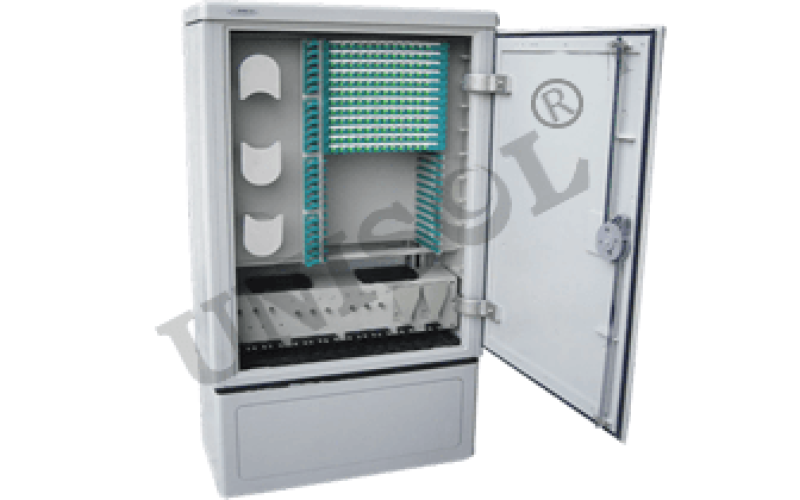- +91 9886004169
- info@unisolcommunications.com



Tensile Force (N): 1000
Pressure Resistance (KPA): 70 ~ 106
Return Loss (DB): PC (≥45DB), UPC (≥50DB), APC (≥60DB)
Ports: 12 to 144
Operating Temperature: -10°C to +40°C
Relative Humidity: 85%
Isolation resistance: ≥1000MΩ/500V(DC)
Anti-voltage strength: ≥3000V(DC)/1min
Durability:>1000 times
ODF Unit by Unisol delivers a premium, high-density fiber management solution designed to organize, protect, and distribute optical fibers in indoor and outdoor network environments. Crafted for telecommunications, data centers, FTTH/FTTP deployments, and central network hubs, Unisol’s ODF cabinet facilitates efficient fiber termination, splicing, and patching while maintaining signal performance and cable integrity under all conditions. Built from durable materials and featuring modular design, this ODF fiber enclosure meets the evolving demands of modern networks.
Constructed to accommodate multiple useful configurations—ranging from ODF 12 port, ODF 24 port, ODF 48 port, ODF 96 port, up to ODF 144 port—this optical distribution solution ensures scalability for growing network needs. Each port supports SC, LC, ST, or MTP adapters, simplifying connectivity regardless of fiber type—single‑mode or multimode. Clear numbering and labeling streamline cable routing, service tracing, and inventory management. High-density ODF units house bend-radius management features and fiberglass trays that maintain proper loop radius and protect against stress-induced signal loss.
The rugged frame of the Unisol ODF cabinet is made from powder-coated steel or aluminum alloy, offering corrosion resistance and mechanical stability. Front‑opening patch panels with dust‑resistant flaps guard connectors, while rear splice trays are accessible without exposing active fibers. Anti‑theft locks and secure panel boxes make this ODF fiber enclosure ideal for facility rooms, telecom booths, and security‑sensitive installations. Cable entry grommets, pre‑punched knockouts, and threaded feed‑throughs support neat routing and strain relief.
Technicians benefit from the modularity of Unisol’s ODF cabinet—patch panels, splice trays, and blank filler panels are interchangeable. Upgrading from an ODF 24 port to an ODF 48 or ODF 96 port setup is as easy as snapping in additional panels. This flexibility supports live network expansion without disruption. Hot‑swap modules and front‑accessible trays enable maintenance without uninstalling the entire unit.
Deployment flexibility extends to both indoor and outdoor usage. When installed indoors, the ODF unit fits 19″ racks or wall‑mount brackets, ideal for data center backbone links and telecom closets. Outdoor versions with environmental sealing and gasketed doors handle FTTP hubs or remote distribution nodes. The same modular trays allow technicians to apply consistent service practices across indoor and outdoor ODF installations.
Impedance-controlled design minimizes insertion loss and reflection, which is crucial for optical signal performance. With high‑density layouts, careful patch cord routing, and organized fiber loops, the ODF cabinet reduces signal interference in high‑port configurations. Built‑in cable bend protectors, slack coils, and fiber guides help align paths and prevent sharp bends—ideal for maintaining performance in large-scale deployments.
Customizable bracket options and lockable handles simplify installation and secure operation. A removable pigtail management panel keeps fiber tails tidy, and patch leads are routed through organized channels to ports. Grounding points support shielded cable protection in heavy‑duty or outdoor ODF installations. Engineers can add fiber fusion splice holders, DC power DIN rails, or splitter adapters to streamline network design and maximize functionality.
For FTTH backhaul and passive network delivery systems, the ODF cabinet serves as an efficient distribution point: feeder fibers enter the cabinet, pass through splice trays or splitters, and exit toward subscriber drops. The flexibility to reconfigure trays supports changing subscriber layouts or incremental upgrades. Industrial‑grade versions offer thermal buffering and silicon gasket seals to maintain fiber lifespans in diverse climates.
Integration with telecommunications headend setups necessitates ODF reliability, and Unisol’s units are tested under electromagnetic and temperature variations. Passive optical systems depend on consistent link performance and fault tolerance, making this ODF unit critical for maintaining redundancy in ring or mesh network topologies.
Technicians appreciate the use of removable front panels and accessible cable channels—a setup where patch cord replacement or rearrangement happens without touching the splice area. Labels and port groupings are silk‑screened, enabling fast identification. These details reduce Mean Time to Repair and improve field service efficiency.
Systems this unit supports include inter-rack cross-connects, optical network terminal (ONT) patching, fusion splice readiness, and breakout connectivity. For fiber-to-the-desktop or fiber-to-the-access deployments, the ODF cabinet provides superior port density while retaining a clean footprint. Scarcity of rack space is no issue in engineered data closet or hub environments.
Professional installers benefit from the inclusion of splice tray mounting plates and blanking options to prevent dust ingress. Optional brushed grommet strips allow patch cables to pass while blocking dust—essential for maintaining clean optical links. Field-upgradeable panels let integrators adjust ports as project scope expands or equipment evolves.
Configuration of each ODF unit follows industry best practices: patch cords are kept above splice trays, fiber slack is stored in internal coils to avoid tension, and cable glands or fan-in plates protect terminations from moisture. This reduces abrasion wear and preserves connector performance in both indoor and outdoor cabinet locations.
ISO-certified manufacture ensures compliance with fire-retardant materials, load-tests, environmental proofs, and fiber-performance metrics. This makes the Unisol ODF unit suitable for enterprise, government, and carrier-grade deployments.
From compact ODF 12 port solutions to multiplexed ODF 144 port high‑density systems, this optical distribution frame provides flexibility, reliability, and professional-grade functionality. It represents a unified platform for cable termination, patch routing, splicing, and secure fiber management across diverse network infrastructures and deployment contexts.
● Provides an efficient system for organizing and managing multiple fiber optic connections in a central location.
● Supports a large number of fiber optic cables, allowing for efficient use of space in data centers and telecom hubs.
● Facilitates fiber optic termination, splicing, and patching, making it ideal for managing fiber-to-the-home (FTTH) and fiber-to-the-premises (FTTP) installations.
● Features a flexible, modular construction that can be scaled to accommodate growing network demands and changes in fiber optic requirements.
● Ensures proper bend radius for optical fibers, preventing damage and signal degradation due to sharp bends in the cables.
● Allows for organized storage of excess fiber length, ensuring neatness and preventing fiber damage.
● Built with high-quality, rugged materials to provide long-term durability and protection for fiber optic connections in both indoor and outdoor environments.
● Equipped with dust-resistant covers to protect sensitive fiber connections from external contaminants.
● Provides secure and organized cable routing to prevent tangling, physical damage, and wear on the fiber cables.
● Compatible with a variety of fiber types, providing flexibility for different types of network setups.
● Designed for quick and easy installation, with accessible ports for patching and maintenance, improving network uptime.
● Often includes anti-theft locks or secure locking mechanisms to prevent unauthorized access to critical network components.
● Accommodates patch panels and fiber adapters for easy connectivity, enabling quick changes or upgrades to the network.
● Can be expanded with additional modules or trays to increase fiber capacity as the network grows.
● Helps optimize network performance by keeping fiber connections organized, reducing clutter, and facilitating easier troubleshooting.
● Data Centers
● Telecommunications Networks
● Industrial Automation and Control Systems
● FTTx Networks
● Passive Optical Networks (PON)
● Campus and Enterprise Networks































Manufacturing Initiatives


Copyright © 2025 | Unisol Communications Pvt Ltd. | All rights reserved.